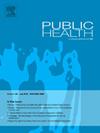The interplay of social and family environments in shaping adolescent health behaviours: a population-based study
IF 3.2
3区 医学
Q1 PUBLIC, ENVIRONMENTAL & OCCUPATIONAL HEALTH
引用次数: 0
Abstract
Objectives
Adolescent health behaviours are key determinants of long-term health. We aimed to explore the associations between clusters of families with similar socio-familial characteristics and health behaviours in both adolescents and their parents.
Study design
The design of the study is a cross-sectional analysis.
Methods
We enrolled adolescents aged 14–17 years and their parents from the SEROCoV-KIDS cohort study (December 2021–June 2022), based in the Canton of Geneva, Switzerland. Marginal logistic regressions were used to compute the sex- and age-adjusted prevalence differences (ΔaPrev) in smoking, alcohol and soda consumption, sport activity, unprotected intercourse, social media addiction, and adherence to COVID-19 vaccination guidelines between socio-familial clusters identified with K-means clustering (disadvantaged vs advantaged).
Results
Among 508 adolescents, two socio-familial clusters were identified: a disadvantaged group of 133 individuals characterised by lower socioeconomic status and social support, and an advantaged group of 375 individuals with more favourable socio-familial conditions. Adolescents in the disadvantaged cluster had a significantly higher prevalence of smoking (ΔaPrev 7.4 %; 95 % CI: 1.1; 14.1), daily soda consumption (ΔaPrev 12.9 %; 95 % CI: 2.6; 23.2), reduced sport activity, and lower adherence to COVID-19 vaccination guidelines. Similar patterns were observed among parents. No differences were found in alcohol use, social media addiction, or unprotected intercourse.
Conclusion
Large disparities in health behaviours associated with socio-familial environments emerge early in adolescence. It is crucial to adopt a holistic health strategy that recognises the interplay between socio-demographic context, family dynamics, and health behaviours.
社会和家庭环境在形成青少年健康行为方面的相互作用:一项基于人口的研究
目的青少年健康行为是长期健康的关键决定因素。我们的目的是探索具有相似社会家庭特征的家庭群与青少年及其父母的健康行为之间的关系。研究设计本研究的设计为横断面分析。方法:我们招募了来自瑞士日内瓦州的SEROCoV-KIDS队列研究(2021年12月- 2022年6月)的14-17岁青少年及其父母。使用边际逻辑回归来计算经性别和年龄调整的吸烟、酒精和苏打水消费、体育活动、无保护性交、社交媒体成瘾和遵守COVID-19疫苗接种指南等方面的流行差异(ΔaPrev),这些差异由k均值聚类确定(弱势群体与优势群体)。结果在508名青少年中,确定了两个社会家庭群体:社会经济地位和社会支持较低的弱势群体133人,社会家庭条件较好的优势群体375人。弱势群体的青少年吸烟率(ΔaPrev 7.4%; 95% CI: 1.1; 14.1)、每日苏打水消费量(ΔaPrev 12.9%; 95% CI: 2.6; 23.2)、体育活动减少以及对COVID-19疫苗接种指南的依从性较低。在父母中也观察到类似的模式。在酒精使用、社交媒体成瘾或无保护性交方面没有发现差异。结论与社会家庭环境相关的健康行为差异在青春期早期就出现了。至关重要的是,必须采取一项全面的卫生战略,承认社会人口背景、家庭动态和卫生行为之间的相互作用。
本文章由计算机程序翻译,如有差异,请以英文原文为准。
求助全文
约1分钟内获得全文
求助全文
来源期刊

Public Health
医学-公共卫生、环境卫生与职业卫生
CiteScore
7.60
自引率
0.00%
发文量
280
审稿时长
37 days
期刊介绍:
Public Health is an international, multidisciplinary peer-reviewed journal. It publishes original papers, reviews and short reports on all aspects of the science, philosophy, and practice of public health.
 求助内容:
求助内容: 应助结果提醒方式:
应助结果提醒方式:


